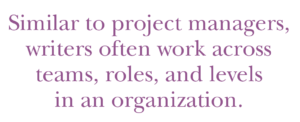By Jessie Mallory
 The demand for technical writers is growing. According to the U.S. Bureau of Labor Statistics, the next 10 years will see faster-than-average growth for those in the technical communication field. This puts writers in an enviable position. However, you may be in an even better position than you realize. The skillset demanded of technical writers is one that can bolster careers outside the technical communication field—think business analyst, product manager, scrum master. For the sake of this article, we’re going to focus on the advantages a technical writing background brings to a career in project management.
The demand for technical writers is growing. According to the U.S. Bureau of Labor Statistics, the next 10 years will see faster-than-average growth for those in the technical communication field. This puts writers in an enviable position. However, you may be in an even better position than you realize. The skillset demanded of technical writers is one that can bolster careers outside the technical communication field—think business analyst, product manager, scrum master. For the sake of this article, we’re going to focus on the advantages a technical writing background brings to a career in project management.
While the day-to-day tasks of a technical writer and project manager can look very different, both are focused on communicating and doing it skillfully. Not only do these skills help to build your career, but they make you more attractive to employers.
Many technical writers are already project managers without the title. You initiate projects, create documentation, anticipate risks, manage versions and translations, identify and work with stakeholders—and do it all against a deadline.
The processes associated with project management study are often broken into knowledge areas. These are the concepts and activities accompanying a field or area of specialization. Processes from many of these knowledge areas are applied each time you work on a project. The documentation and interrogative skills of a technical writer lend themselves especially well to some of these knowledge areas, specifically integration, stakeholder, scope, time, and communication management.
Integration Management
In project management, integration represents the identification and unification of processes and activities to meet project requirements. Integration work spans the entire life of a project. At project inception, project managers define why the project exists and create the project management plan, which describes how the project will be carried out and monitored. During the life of the project, the project manager uses integration processes to help direct the work being done, compare that work against what is expected, and track any changes made. At the end of the project, the project manager ensures that the project has met its objectives and can be closed.
As you might guess, the integration processes require a lot of documentation. Before the project is even started, a charter must be drafted and approved. Then there is the massive task of pulling together and documenting all the pieces of the project management plan. The project management plan is the document that describes how different parts of the project like communications and scope will be addressed. The project management plan and the charter must be accurate and consistent as they set project goals and boundaries and are used to measure whether a project is on track.
Someone with a communications background brings added experience that’s beneficial to business. We can easily understand the implications of not involving technical writers early enough in a project. Writers who are working alongside a project as it progresses have the benefit of understanding the product or deliverable from its initiation. This means they need much less ramp-up than if pulled in at the end of a project. There are also the day-to-day benefits of having a writer around. Writers can edit content on the go, ensure consistency, craft clear user messages, and perhaps reduce the rounds of translations needed. This can reduce project costs for businesses, and have a positive impact on the bottom line.
Stakeholder Management
Stakeholders are similar to a document’s audience. A stakeholder is anyone who can impact or is impacted by a project. This can be a broad group of people depending on the project, product, or organization. Stakeholder management consists of identifying the stakeholders, planning how to engage them based on their interests and project impact, and monitoring and communicating with those stakeholders throughout the life of the project.
Stakeholder satisfaction is always a key project objective. To meet this goal, the project manager is responsible for first learning more about the stakeholders. This means identifying the people or groups who could be affected by decisions or outcomes of the project. Stakeholder management then requires the extra step of understanding the influence, level of involvement, and interdependencies between stakeholders. The ability to quickly identify and effectively address the key stakeholders’ needs can streamline the process and improve overall business efficiency.
This learning phase is an easy shift for a technical communicator who is already experienced in identifying an audience’s needs and interests. The project manager documents these stakeholder requirements as part of the project management plan.
A more difficult move for a technical writer may be the monitoring and controlling of stakeholder engagement. Though this particular task isn’t necessarily an easy transition, it’s not far removed from the technical writing skill set. Technical writers are constantly engaging with their subject matter experts.
Scope Management
Project scope management is ensuring that the work required, and only the work required, is part of the project. A large part of managing scope is collecting requirements and clarifying what is or isn’t in scope. This involves creating a work breakdown structure (WBS), which is an itemization of the work to be completed. The WBS is a sub-component of the project management plan.
The WBS is another illustration of how beneficial technical writing skills can be to a project manager. Getting it right requires an in-depth understanding of processes and deliverables. This is achieved through effective conversations and rigorous questioning. These are skills that technical writers have in spades.
Writers are constantly working hand-in-hand with their teams and stakeholders to understand the product and ensure their documentation is both correct and complete. Effective documentation supports users, reduces service calls, and reduces overall costs for the organization.
Time Management
Time management is an incredibly important part of project management. It includes defining and sequencing of activities based on requirements and the relationships between work items. It’s the clarification of activity resource requirements and how resource availability will affect activity durations or sequencing. It’s then developing a comprehensive schedule that takes all of this information into account and abiding by that schedule to ensure a timely completion.
As writers, we often have to manage our own documentation projects, whether working in a team or alone. Technical communicators are very capable of asking questions to learn the ins and outs of a process, product, team, or deliverable. Effective questioning skills make technical communicators especially skilled at discovering the activities that must be accounted for in a schedule and very adept at discussing status with their teams. A writer’s ability to dig into an issue and learn its cause or consequence is beneficial when learning more about risks that could impact the project schedule. Communicators are often able to hit the ground running, reducing the learning curve to deliver business-critical outcomes.
 Communications Management
Communications Management
The majority of a good project manager’s time is spent communicating. Projects are a mountain of information coming in and needing to go out. At the beginning of a project, the project manager creates the communication plan. This is another sub-component of the project management plan. The communication plan details types of communications, audience, sender, frequency, and sometimes where important information will be stored. It is an essential part of managing efficient and effective communications. Communications are designed according to the needs of the stakeholders. Once the up-front planning is complete and stakeholder requirements are understood, the project manager spends their days communicating with the various stakeholders.
It’s easy to see how a technical writer could excel at the written side of project communications. Developing a communication plan or crafting the perfect email to sum up the status of a project will come easily to any technical writer. But a technical communication background offers so much more than just writing ability. To stay current with a product or project, writers are constantly communicating with their team members, asking questions and developing relationships. Similar to project managers, writers often work across teams, roles, and levels in an organization. This comfort with written or in-person communication, regardless of team boundaries or hierarchies, is a huge benefit to a writer-turned-project manager, and the businesses who hire them.
Opportunities Await
Few careers progress in a straight line. Instead, they’re a map of the turns and reroutes we’ve taken as our positions change. Happily, the skillset of a technical writer is one that can be advantageous in several other fields.
Project management requires a prodigious amount of communication and documentation: plans, charters, models, emails, meetings, etc. A technical communication background is a boon to anyone interested in a career in project management. This is great news for technical writers as it opens opportunities in another career path that’s growing just as quickly as technical communication.
JESSIE MALLORY (www.linkedin.com/in/jessiemallory) is a Senior Scrum Master for cybersecurity and investigative software. She has served as a Director on the STC Board, President for the STC Philadelphia Metro Chapter, and Director for the Project Management Institute Delaware Valley Chapter. Her interests include team management, continuous improvement, and student outreach.
References
Project Management Institute. 2013. A guide to the Project Management Body of Knowledge (PMBOK guide), 5th ed. Newtown Square, PA: Project Management Institute, Inc.
U.S. Bureau of Labor Statistics. n.d. “Occupational Outlook Handbook.” Accessed 8 March 2021. https://www.bls.gov/ooh/media-and-communication/technical-writers.htm.


